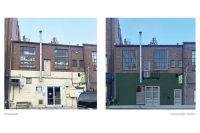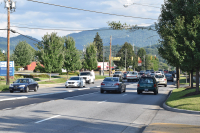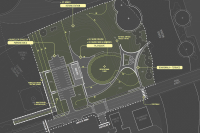A family full of marriage, but not quite bliss
Editor’s note: This George Ellison column was first published in December 2004.
Most everyone agrees that marriage is a noble institution. But even in the best of situations it can be, at times, a demanding proposition. Some folks seem to be especially star-crossed when it comes to matrimony. Have you ever noticed that extraordinary marital situations seem to run in certain families? Don’t ask me why.
Behold, for instance, the example of the Calloway sisters, who resided in the North Carolina mountains during the early 19th century. Fanny and Betsy Calloway were the daughters of Ben Calloway, one of the first settlers on the Watauga River in the northwestern corner of the state. Both sisters were celebrated for their grace and beauty. Both, alas, had complicated spousal issues.
Fanny married John Holtsclaw, a Baptist preacher. They had seven children. Around 1825 Holtsclaw encountered Delilah Baird, the 18-year-old daughter of Col. Bedent Baird of Valle Crucis. Delilah was willing to elope with Holtsclaw so long as they went somewhere far away like, say, Kentucky.
“Why certainly, Delilah, we shall go to Kentucky,” Holtsclaw said, or something like that. He then proceeded to take her via horseback on such a roundabout and circuitous journey through the mountains in the immediate vicinity that the poor girl thought she had arrived in Kentucky. In reality, she was on the Big Bottoms of the Elk River, a mile from Banner Elk and only several miles from her childhood home.
Holtsclaw owned land along the river bottom and, with foresight, had already constructed their “love nest.” This was a camp, consisting of a bark structure built against the trunk of a large fallen tree. “For a long time this was their home. Their bed consisted of a heap of dry leaves and grass upon the ground; their stove was a crude furnace outside the door. Chairs? They were large stones. When Delilah wished to primp, her mirror was the placid waters of Elk River. Or so the story goes. We know that something like this took place, but just where fact leaves off and fable begins is difficult to discern.
Related Items
It was here that Delilah’s first child, Alf Baird, was born. Alf is said to have been the first white child born in what is today Banner Elk. Later on the family moved into a rude cabin lower down the river, “where they settled in apparent harmony.”
Delilah liked to dig ‘sang in the fall of the year. One day when she had wandered far afield hunting roots she heard a cowbell jingle, the first cowbell she had ever heard in Kentucky. As she listened, it sounded more and more like the bell on “Old Jers,” her father’s cow far away in North Carolina. Several days later she returned and followed the cow down a hollow and across a ridge, where, lo and behold, she found herself in her father’s backyard at Valle Crucis!
(Despite now being aware of her long deception, Delilah not only renewed her ties with her own family but continued to live with Holtsclaw, not in “Kentucky,” but just over the ridge. In time he built her a fine white house overlooking the Big Bottoms of the Elk.
Fanny (Calloway) Holtsclaw, whose place Delilah had usurped, one day came to their door, asking to be allowed to spin, weave, wash, hoe or do anything that would provide John Holtsclaw’s children with bread. No one knows how Delilah reacted. Holtsclaw’s response was to deed all 480 acres of his Elk River land to Delilah and her descendants.
But what goes around comes around. Among Fanny’s children was a girl named Raney. One of her sons, James Whitehead, bought up all of the acreage Holtsclaw had deeded to Delilah.
Now we return to Betsy Calloway, Fanny’s sister. She was living at home in 1819 when a handsome fiddler and hunter named James Aldridge arrived in the community. (That he was fiddler should have been a warning sign to the girl, but she was young and didn’t know about wayfaring fiddlers.) He was attractive and appeared to be single. Soon, of course, they married and settled in a large cabin.
Everything went fine for about 15 years. They had seven children. Then a fur trader named Price happened into the region. Price instantly recognized Aldridge as “Fiddling Jimmy.” And he knew Mrs. Aldridge number 1, who, with their five children, was still living on the Big Sandy River on what was then the Kentucky-Virginia border (now West Virginia). When he went north again, he promptly shared news of his discovery with the original Mrs. Aldridge.
She soon appeared on the North Carolina scene. Details of what transpired between the two Mrs. Aldridges are scant. It is recorded, however, that “Fiddling Jimmy” came by the local millhouse the day his first wife appeared and told the boys: “Well, the cat is out of the bag.” Of Mrs. Aldridge number 2, he said: “She is sulky, but since I’m treating both women exactly alike [there’s] no doubt she will get over it.”
At some point after Mrs. Aldridge number 1 returned to the Big Sandy, several of her children by “Fiddling Jimmy” appeared on the scene in the Banner Elk area further complicating matters. When relations between Mrs. Aldridge number 2 and “Fiddling Jimmy” cooled, he headed up to the Big Sandy to try and patch things up with Mrs. Aldridge number 1. This didn’t work out either. When Mrs. Aldridge number 2 came north to check one last time on “Fiddling Jimmy” (her first “real” visit to Kentucky), she found him living with a young girl in a hut.
Back home on the Elk River, Betsy managed to raise her own children and, occasionally, the children from her husband’s first marriage. It is recorded: “She died in 1900 a well-respected woman.”
(Note: The primary sources for this account are John P. Arthur, A History of Watauga County (1915); Horton Cooper, The History of Avery County, North Carolina (1967); Carolyn Sakwoski, Touring the Western North Carolina Backroads (1990); and an anonymous, online article published by the Watauga News at www.mountaintimes.com/summer/lore_calloway.php3.)
George Ellison wrote the biographical introductions for the reissues of two Appalachian classics: Horace Kephart’s Our Southern Highlanders and James Mooney’s History, Myths, and Sacred Formulas of the Cherokees. In June 2005, a selection of his Back Then columns was published by The History Press in Charleston as Mountain Passages: Natural and Cultural History of Western North Carolina and the Great Smoky Mountains. Readers can contact him at P.O. Box 1262, Bryson City, N.C., 28713, or at This email address is being protected from spambots. You need JavaScript enabled to view it..









